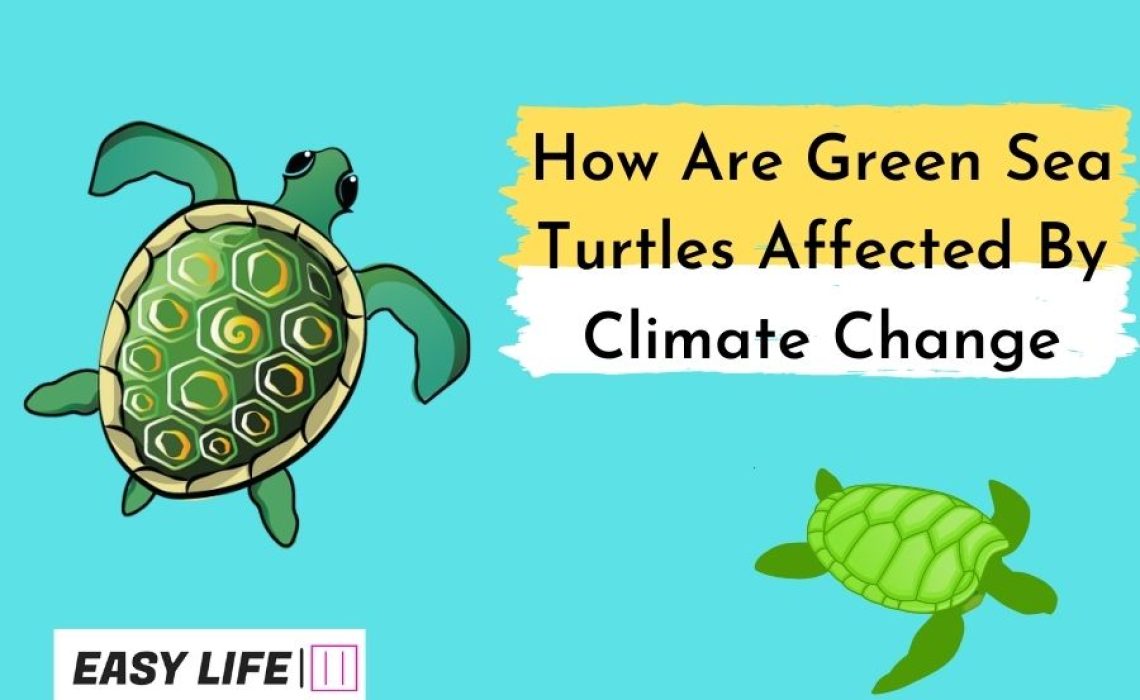Green sea turtles (Chelonia mydas), gentle giants of the ocean, face numerous challenges in their quest for survival. Climate change, a growing global concern, adds to these hurdles, influencing various aspects of their life cycle. In this article, we examine the intricate ways green sea turtles are affected by climate change and the potential consequences for their future.
h, the green sea turtle! An iconic species, these majestic creatures have graced the oceans for over 100 million years. As marine reptiles, they play a vital role in maintaining the health of the ecosystems they inhabit. Let’s dive deeper into the life of green sea turtles.
Table of Contents
Toggle#Green Sea Turtles
Biology and Appearance
- Size and shape: Green sea turtles (Chelonia mydas) are known for their large, streamlined shells called carapaces, which can grow up to 5 feet in length. Adult turtles can weigh between 240 and 420 pounds.
- Colouration: The name “green” sea turtle may be a bit misleading, as their shells are usually a blend of brown, black, and olive hues. However, the greenish-coloured fat underneath the shell is the source of their name.
Habitat and Distribution
- Location: You can find green sea turtles in the tropical and subtropical waters of the Atlantic, Pacific, and Indian Oceans.
- Preferred environments: They inhabit coastal areas, such as bays, lagoons, and coral reefs, where they find abundant food and suitable nesting grounds.
Diet and Feeding Habits
- Herbivores: Green sea turtles are unique among sea turtles, as they mainly consume seagrasses and algae. Their serrated jaws are perfectly adapted to munch on vegetation.
- Juvenile diet: Interestingly, young green sea turtles start life as omnivores, eating small invertebrates like jellyfish and crustaceans, before transitioning to a primarily herbivorous diet.
Reproduction and Lifespan
- Nesting: Green sea turtles have a complex nesting process, with females returning to their natal beaches to lay eggs every 2-4 years. They dig pits in the sand, depositing around 100-200 eggs, before covering them up and returning to the sea.
- Hatching: After approximately two months, the hatchlings emerge and make a perilous journey to the ocean, facing numerous predators.
- Lifespan: Green sea turtles have a long life, living up to 80 years or more.
Conservation Status and Threats
- Endangered: The IUCN Red List classifies green sea turtles as endangered, with the primary threats being human activities such as habitat loss, pollution, and accidental entanglement in fishing nets.
- Climate change: Rising sea levels and changing temperatures pose additional threats to green sea turtle populations. As they impact nesting beaches and alter sex ratios in hatchlings.
Efforts to Protect Green Sea Turtles
- Legal protection: Many countries have laws in place to protect green sea turtles from direct harm, such as hunting or egg collection.
- Conservation initiatives: Programs like turtle excluder devices (TEDs) in fishing nets, beach cleanups, and habitat restoration projects aim to reduce threats to green sea turtles and their habitats.
In conclusion, green sea turtles are remarkable creatures that have adapted to thrive in their marine environments. Although they face significant challenges, ongoing conservation efforts give hope for the future of these ancient reptiles.
Green Turtles Affected By Climate Change
here are some point why green turtles affected by climate change
-
Rising Temperatures: A Balancing Act
As the Earth’s climate warms, the temperature of nesting beaches rises, affecting green sea turtles in multiple ways:
- Sex determination: Green sea turtle hatchlings’ sex depends on incubation temperature, with warmer nests producing more females. As temperatures rise, the sex ratio skews, threatening the long-term sustainability of their populations.
- Hatchling survival: Higher sand temperatures can harm developing embryos, reduce hatchling success, and impair the fitness of emerging turtles.
- Nesting site shifts: Climate change may cause suitable nesting beaches to become scarce or unsuitable, forcing turtles to seek alternative locations with potentially increased risks.
-
Ocean Acidification: A Threat to Their Home
Increased CO2 levels lead to ocean acidification, which can indirectly impact green sea turtles:
- Seagrass decline: Acidification can negatively affect seagrass, a primary food source for green sea turtles, potentially reducing the availability and quality of their preferred diet.
- Coral reef degradation: Ocean acidification endangers coral reefs, essential habitats for juvenile turtles and the myriad species they rely on for sustenance and protection.
-
Sea Level Rise: A Battle for Beaches
Rising sea levels, driven by climate change, pose significant challenges for green sea turtles:
- Nesting beach erosion: Sea level rise can erode or inundate nesting beaches, reducing available nesting habitat and increasing competition for suitable sites.
- Nest flooding: Higher sea levels and storm surges can flood nests, drowning embryos or washing away eggs, impacting hatchling success rates.
-
Extreme Weather Events: Nature’s Fury Unleashed
Climate change can exacerbate the frequency and intensity of extreme weather events, affecting green sea turtles:
- Storm damage: Strong storms can devastate nesting beaches, destroy nests, and displace adult turtles, potentially reducing reproductive success.
- Altered migration patterns: Changes in ocean currents and temperatures may affect migration routes and timing. Impacting turtles’ ability to find food and nesting sites.
What are 5 interesting facts about green sea turtles?
- Name Origin: The name “green” sea turtle does not come from the color of its shell, which is typically brown or olive depending on its habitat. Instead, the name comes from the green color of its body fat, which is a result of their herbivorous diet, primarily composed of seagrasses and algae.
- Long Lifespan: Green sea turtles can live for up to 80 years or more in the wild. They take a long time to mature; they don’t start to reproduce until they are between 20 to 50 years old.
- Migration: These turtles gain recognition for their long-distance migrations between feeding grounds and the beaches where they hatched.. Some green turtles migrate over 1,400 miles to reach their nesting sites.
- Nesting Behavior: Females return to the same beach where they were born to lay their eggs. They usually do this at night, climb the beach, and dig a pit in the sand where they deposit their eggs. After covering the nest with sand, they return to the sea.
- Temperature-Dependent Sex Determination: The sex of a green sea turtle is determined by the temperature of the sand where the eggs are incubated. Warmer temperatures tend to produce more females, while cooler temperatures produce more males. This is one reason why climate change is a particularly significant threat to these creatures.
Conclusion: Green Sea Turtles Affected By Climate Change
Climate change poses a complex array of challenges for green sea turtles, threatening their survival and overall population health. Understanding these impacts is essential for developing effective conservation strategies and fostering a sustainable future for these remarkable creatures. By addressing climate change and protecting critical habitats. We can help ensure that green sea turtles continue to grace our oceans for generations to come.
Read this Article: How Are Pandas Affected By Climate Change?






